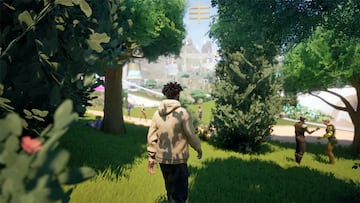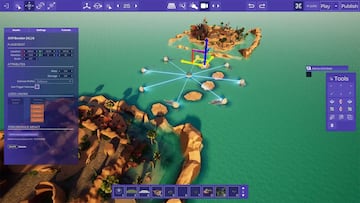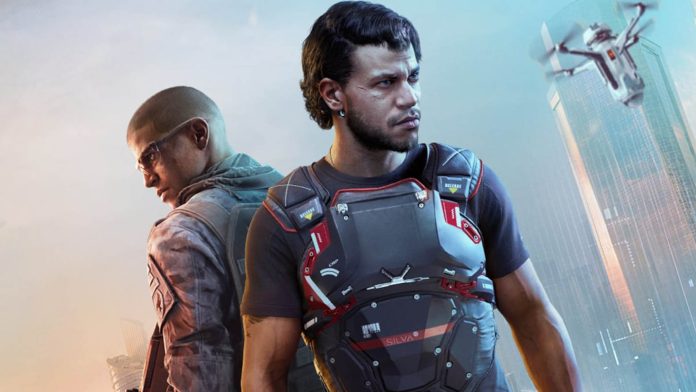Throughout the history of video games, we have seen great failures of all kinds: from Atari 2600’s E.T. The Extra-Terrestrial, which ended up with hundreds of copies buried in the desert, to the numerous delays of Duke Nukem Forever, which culminated in a title that left even the most diehard fans unsatisfied. Today, we’re going to talk about MindsEye, which was set to be one of the great games of 2025, but has turned out to be an unfulfilled promise, and its creators are facing a massive wave of layoffs after its critical and sales flop. However, to know the real reasons for its downfall, it is necessary to know the history of its development, and that of the Everywhere platform, which was intended to be a real revolution.
The Origins: Everywhere as the new metaverse and the “GTA killer”
Everywhere is the name given to the ambitious project that emerged from the minds of three key former Rockstar Games employees: Leslie Benzies, Matthew Smith and Colin Entwistle. These three minds, disenchanted with their work at the company that created Grand Theft Auto, decided to try their luck by creating their independent studio in 2016, called Royal Circus Games. Benzies was the most prominent figure, having been key in best-selling titles such as Grand Theft Auto III, Grand Theft Auto: San Andreas and Grand Theft Auto V.

Full screen
With Everywhere, the intention was clear: they wanted to emulate the success of Grand Theft Auto Online in creating a persistent online world. Its creators aspired not to create the umpteenth massively multiplayer online video game, but to give life to a whole metaverse, powered by a game creation platform where users themselves could contribute and make it have a technically unlimited duration and replayability, framed within a context of “social MMO” Roblox style. It was an exclusive development for PC, and was never announced for consoles.

Full screen
At first, everything seemed to be going well; in January 2017, the studio had already thirty employees in size. However, in 2018 came the first setback. Rockstar, very wary of protecting its name and reputation, sent a threatening missive to its former employees urging them to change the company’s name. They argued that the acronym RCG was too similar to Rockstar Games’ RSG. Royal Circus Games chose to follow the recommendation, and the studio’s name was changed to Build A Rocket Boy.
“Everywhere”, but nowhere really
After the studio’s name change, Build A Rocket Boy continued development of Everywhere, continuing to hire staff and increase its ambition… but without delivering tangible results. In 2020, the development of the platform switched to Unreal Engine 5, by then the latest version of Epic Games’ popular engine, which offered advantages such as advanced physics and photorealistic lighting, and graphics.

Full screen
Set in the fictional city of Utropia, Everywhere players could access a variety of gameplay experiences, including rich and varied biomes around the main city, as well as the opportunity to play experiences created by other users. This platform was conceived as an open-world game where players could let their imagination run wild. Indeed, the comparisons with Roblox were not misplaced, but Everywhere had the advantage of having state-of-the-art graphics. However, like everything that seems too good to be true, the concept began to show the seams.
The first time Everywhere could be considered to have shown signs of life as such was at Gamescom 2022. At this show, a teaser of just over a minute was presented that let the imagination run wild: Everywhere would allow immersive experiences of all kinds to be built, and promised to become the ultimate video game creation experience. In addition, there was a release date, albeit limited: 2023.
Indeed, in 2023, there was an invitation-only playable alpha, which passed without much fanfare, barely generating any media traction. At this point, it was clear that, in order to generate interest in the platform, it was necessary to create an experience that would serve as a benchmark to demonstrate what Everywhere was truly capable of. This is how the development of MindsEye began, the first “premium” experience within this ecosystem, and the long-awaited killer app that would give real value to Everywhere’s proposal.
From Everywhere to MindsEye
The development of MindsEye as such began in 2023, and, a priori, it was born as a video game divided into episodes that was going to be free to play, but exclusive to the Everywhere platform. Again, it was an extraordinarily ambitious project, and at a certain point in development, there was talk that each episode would take place in different periods of history and even different places in the universe, although with a connected narrative as an anthology.

Full screen
However, it was clear that Build A Rocket Boy had again fallen into its own trap, and they were chewing more than they could swallow, so the scale of the project and even the release was rethought, affecting Everywhere. In 2024, on the project’s official subreddit, even the most enthusiastic users began to distrust because the developers kept dragging their feet regarding the expected “final version” that never arrived, and in 2025, a couple of months before the release of MindsEye, it became clear that the latter game had phagocytized Everywhere, its “progenitor”.
After several years of unfulfilled promises, Build A Rocket Boy decided to quietly cancel Everywhere to focus its efforts on MindsEye, turning the project into a commercial game available on PC, PS5, and Xbox Series X|S, and thus start generating direct profits. However, the scale of the project changed drastically, and the final version was defined as “a narrative action-adventure thriller,” set in a pseudo-open world. As interesting as the proposal was, there were several glaring red flags before the June 2025 launch.
First of all, no review codes were sent to the press media. Secondly, both the company’s chief legal officer and chief financial officer resigned just two weeks before the release date. The disbandment of key personnel and the studio’s opacity did not bode well; everything pointed to an imminent catastrophe, and those with inside information decided to abandon ship before it sank.
MindsEye, one of the worst video games of the generation… and of all history
When MindsEye hit physical and digital stores on June 10, 2025, many could not believe what they were seeing on their screens. It was a very powerful game visually, thanks to Unreal Engine 5, yes, but it didn’t really offer anything else. Its development and narrative were excessively simplistic, and, according to many testimonies, the gameplay scheme reminded of “the worst of GTA missions,” where if you leave the ‘script’ or the defined game area, you will repeatedly see the message “mission failed”. Many agree that the gameplay is outdated and that it feels like it’s from the turn of the century.

Full screen
To top it all off, the game was released with bugs and glitches of all kinds and with a very rudimentary AI that barely reacts to the protagonist’s actions, serving as moving targets and little else. The result has been a real mess in the middle of 2025, especially considering the origin of the project as an intended “GTA killer”.
The reactions from critics and the public were not long in coming: currently, MindsEye boasts an embarrassing 38/100 on PC and 28/100 on PS5 on Metacritic. Normally, it is very difficult for a video game to fail a rigorous analysis, because it practically has to do the opposite of actively entertaining. And it seems that this title succeeds.

Full screen
The consequences for the studio have not been slow in coming. On the one hand, Mark Gerhard, co-CEO of the studio, defended the game tooth and nail, going so far as to claim on Discord that the negative reviews were part of a boycott campaign, indirectly pointing the finger at Rockstar Games. To avoid facing this titan in court, Hakan Abrak, CEO of IO Interactive, who published MindsEye, had to deny these unfounded accusations. On the other hand, the company has begun a layoff process that could affect at least one hundred workers, which is estimated to be at least one-fifth of the total workforce. In any case, the situation does not look good for Build A Rocket Boy.
The aftermath of disaster: Is there a future for MindsEye and Build A Rocket Boy?
While it is true that situations like Cyberpunk 2077 have shown that with constant work and good faith, it is possible to win back critical and public favor after a disastrous launch, this does not seem to be the case for MindsEye and Build A Rocket Boy. There doesn’t seem to be a single culprit responsible for this quagmire, although, at the very least, there are unrealistic aspirations, as well as a lack of clear project vision, or a more staggered development with tangible goals.

Full screen
That what in 2016 was a simple three-person studio created by former Rockstar employees has grown to half a thousand employees in less than a decade indicates that there was an extraordinarily worrying management problem, especially considering that, during all this time, not a single product or video game was released that could justify such a size for a developer.
While it is true that Leslie Benzies was a key player in the leap from 2D to 3D in the Grand Theft Auto saga, you can’t live off the rent indefinitely in the video game industry, and you have to be on the ball to stay relevant. Technological progress is advancing by leaps and bounds, and new technologies, as well as available tools such as artificial intelligence, are constantly changing the landscape of the video game industry.
Perhaps, in an alternate timeline, Everywhere would be what Fortnite has already achieved, because it is the closest thing currently to the original vision of its creators. This popular video game from Epic Games pivoted from being a bland PvE game to becoming the most successful battle royale of all time, and, since its launch in 2017, it has been adding experiences of all kinds: music game modes (Fortnite Festival), racing (Rocket Racing), construction and survival (LEGO Fortnite), as well as offering its users the tools to create anything they can imagine through its powerful Creative Mode, powered by Unreal Engine. And this is not to mention its numerous collaborations with both real-world personalities.
In short: with the failure of MindsEye and Everywhere, we have seen live the derailment of a project that swore to be the next revolution in the electronic entertainment scene, to join many others that ended up in oblivion. In this way, Build A Rocket Boy’s projects are now part of a list of famous -or infamous, depending on how you look at it- names such as Daikatana, Too Human, or Babylon’s Fall.
Follow MeriStation USA on X (formerly known as Twitter). Your video game and entertainment website for all the news, updates, and breaking news from the world of video games, movies, series, manga, and anime. Previews, reviews, interviews, trailers, gameplay, podcasts and more! Follow us now!
